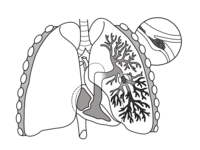
Photo from wikipedia
Chronic venous disease (CVeD) is defined as a set of disorders affecting the venous system mainly manifested in the form of varicose veins. CVeD is characterized by a sustained venous… Click to show full abstract
Chronic venous disease (CVeD) is defined as a set of disorders affecting the venous system mainly manifested in the form of varicose veins. CVeD is characterized by a sustained venous hypertension, leading to a plethora of functional and structural changes in the vein that may cause valve incompetence and pathologic reflux. In turn, venous reflux aggravates the venous hypertension and enhances the progression of CVeD into the most advanced stages. Previous studies have proposed that there are several alterations in the venous wall preceding the valve dysfunction and venous reflux. Besides, it has also been identified that young patients with CVeD present premature aging and changes in the venous wall composition that may be related to the presence of venous reflux. In this context, the aim of the present study is to examine the possible pathophysiological role of elastic fibers and their precursors in the venous wall of patients with reflux in comparison to those without reflux, considering the variable age in both groups (<50 years and ≥50 years). We performed immunohistochemical and quantitative polymerase chain reaction (PCR) in order to assess the protein and gene expression of tropoelastin, fibrillin-1, fibulins 4 and 5, lysyl oxidase and lysyl oxidase like 1, respectively. In parallel, we assessed the elastin content through histological techniques (orcein stain) in this group of patients. Our results show significant changes in elastic fibers and their precursors in young patients with pathologic reflux when compared with elder patients with reflux and young patients without reflux. These variations suggest that the venous system of young patients with venous reflux appears to present an enhanced dynamism and arterialization of the venous wall, which may be associated with a premature aging and pathological environment of the tissue.
Journal Title: Journal of Personalized Medicine
Year Published: 2022
Link to full text (if available)
Share on Social Media: Sign Up to like & get
recommendations!